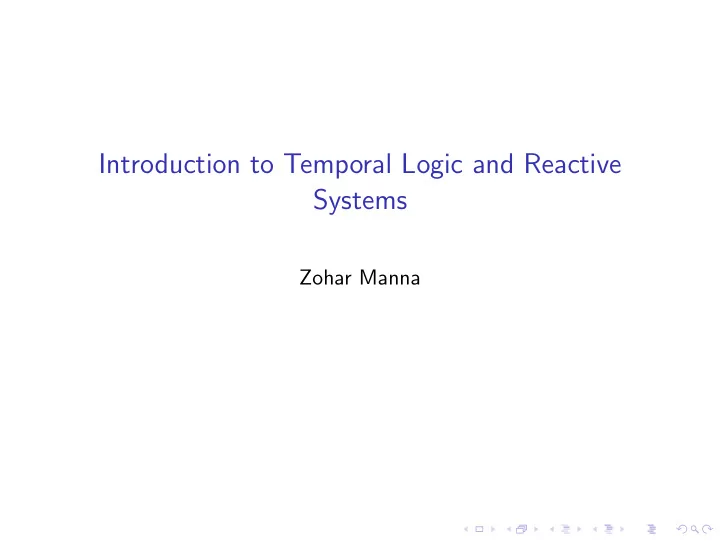

Introduction to Temporal Logic and Reactive Systems Zohar Manna
◮ Verification of sequential programs. ◮ No concurrency. ◮ Programs (should) always terminate. ◮ Observable at start (input) and end (output) of execution. ◮ Logical foundations: ◮ FOL. ◮ Invariants and ranking functions. ◮ Verification conditions. ◮ Decision procedures. ◮ Induction.
◮ Verification of reactive systems . ◮ Highly concurrent. Concept of fairness . Properties: mutual exclusion , freedom from deadlock . ◮ Programs need not terminate (e.g., OS, web server). But some components must terminate (e.g., IO handler). ◮ Observable throughout execution. And the environment affects execution. ◮ Logical foundations: Everything from CS156 plus ◮ temporal logics linear (LTL), branching (CTL), alternating (ATL) time ◮ automata theory and connection with temporal logics infinite strings (linear) and trees (branching, alternating)
prime local y : integer where y = 1 ℓ 0 : loop forever do . . . ℓ 5 : print y ℓ 6 : . . . ℓ 10 : y ← y + 1 . . . Output: 2,3,5,7,11,13, . . . ◮ only primes: � [ at ℓ 5 → prime( y )] ◮ all primes: ∀ u . [prime( u ) → ♦ ( at ℓ 5 ∧ y = u )] ◮ monotonicity (correct order): ∀ u . � [( at ℓ 6 ∧ y = u ) → � ( at ℓ 5 → y > u )]
bakery y 1 , y 2 : integer where y 1 = 0 , y 2 = 0 local P 1 :: loop forever do ℓ 0 : noncritical ℓ 1 : y 1 := y 2 + 1 ℓ 2 : await y 2 = 0 ∨ y 1 ≤ y 2 ℓ 3 : critical ℓ 4 : y 1 := 0 || P 2 :: loop forever do m 0 : noncritical m 1 : y 2 := y 1 + 1 m 2 : await y 1 = 0 ∨ y 2 ≤ y 1 m 3 : critical m 4 : y 2 := 0
Requirements for bakery ◮ Mutual exclusion � ¬ ( ℓ 3 ∧ m 3 ) The two processes are not in the critical section simultaneously. ◮ One-bounded overtaking ℓ 2 ⇒ ¬ m 3 W m 3 W ¬ m 3 W ℓ 3 Once P 1 waits to get access, P 2 can enter its critical section at most once. ◮ Progress ℓ 1 ⇒ ♦ ℓ 3 Once P 1 shows interest in entering its critical section, it eventually gets access to the critical section.
Administration ◮ Instructor: Zohar Manna ◮ Text: The Temporal Verification of Reactive Systems: Safety Zohar Manna and Amir Pnueli Springer-Verlag 1995
Recommend
More recommend